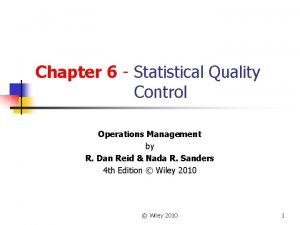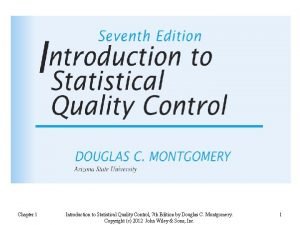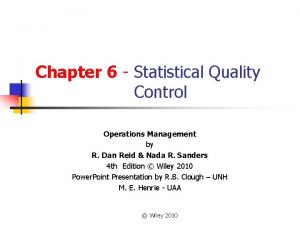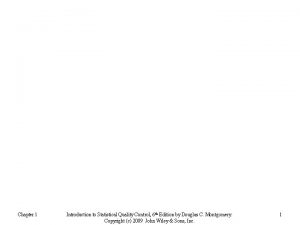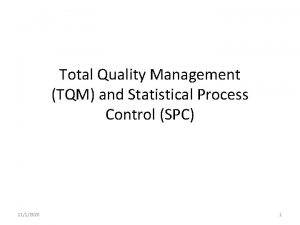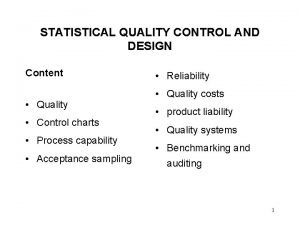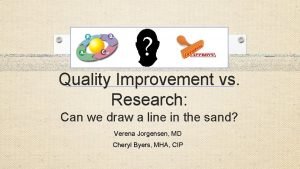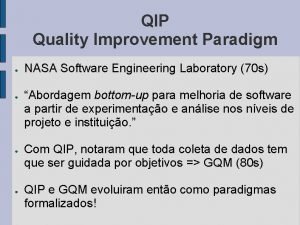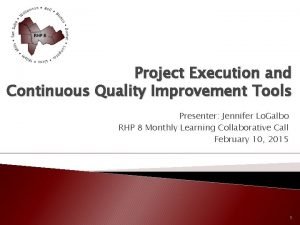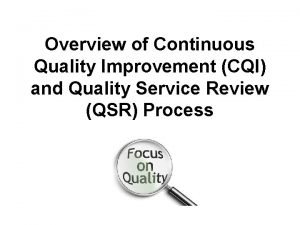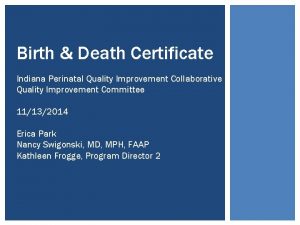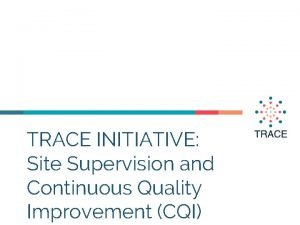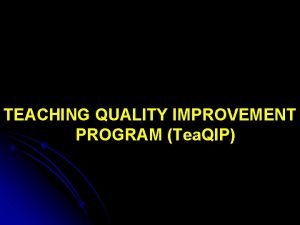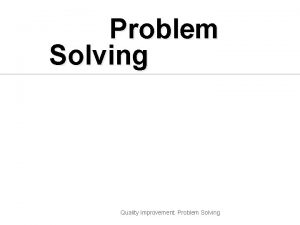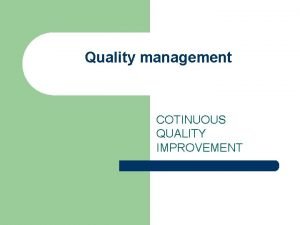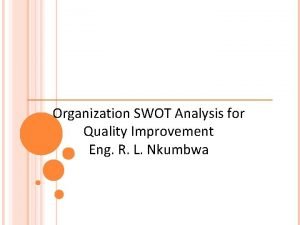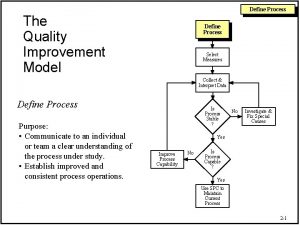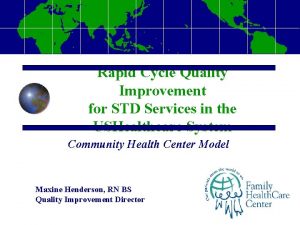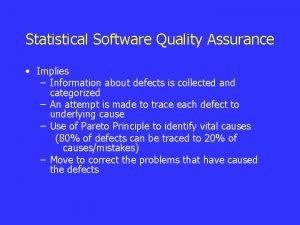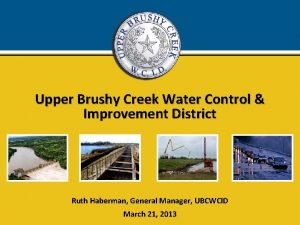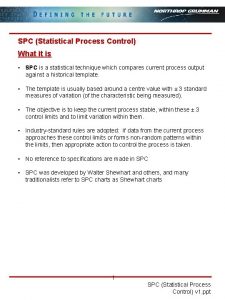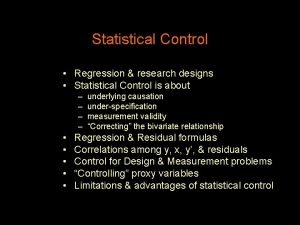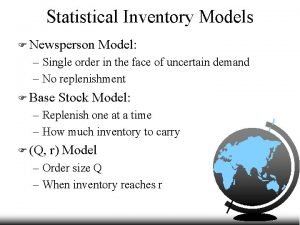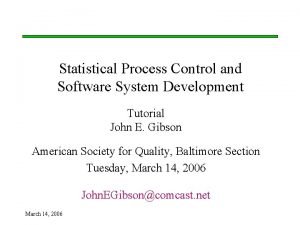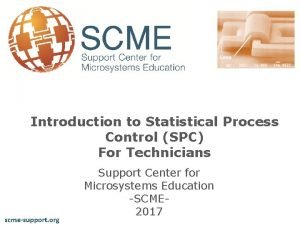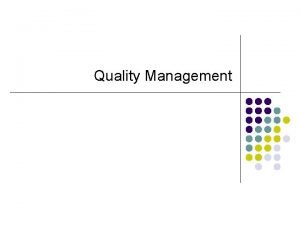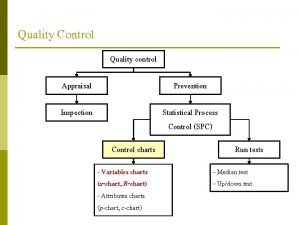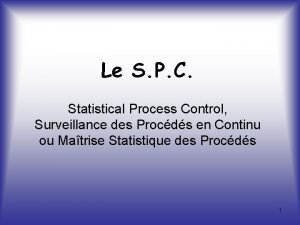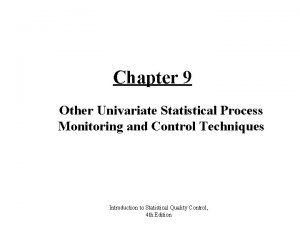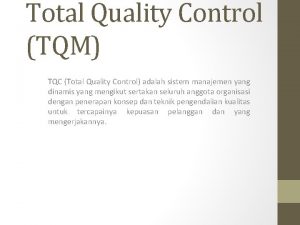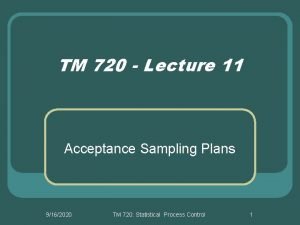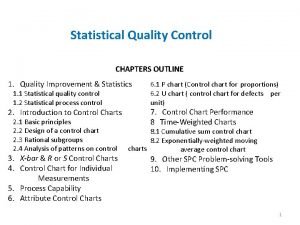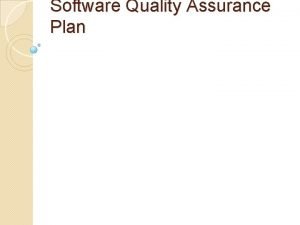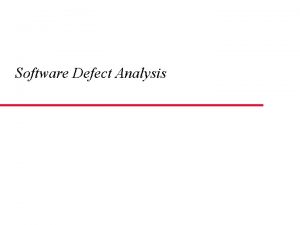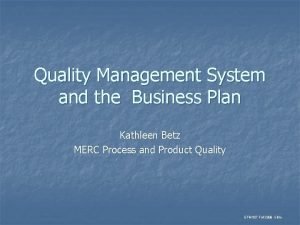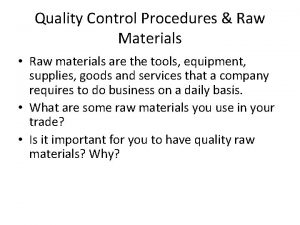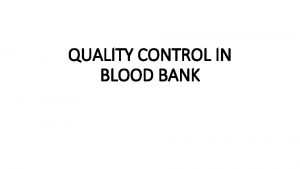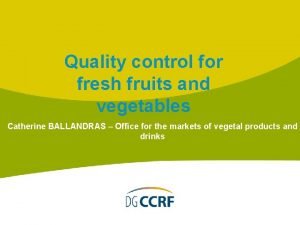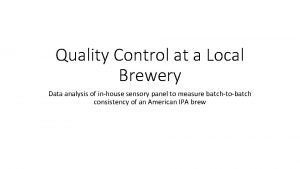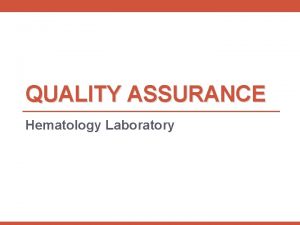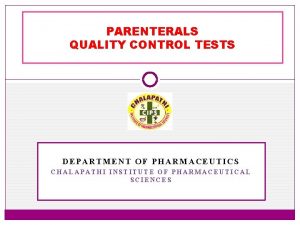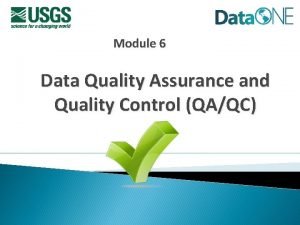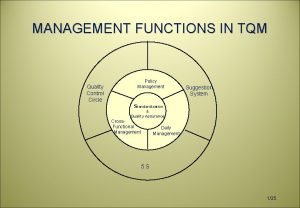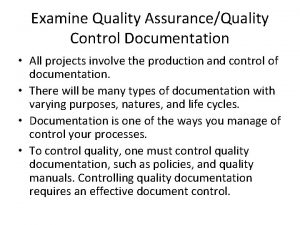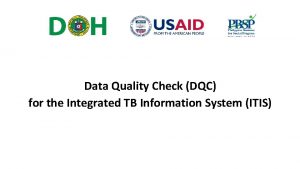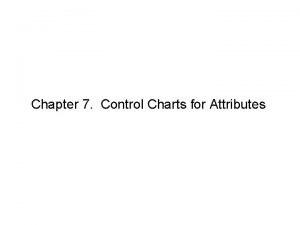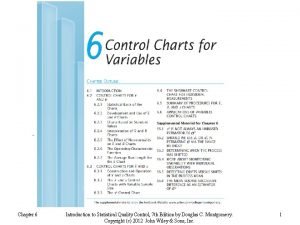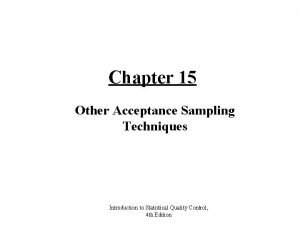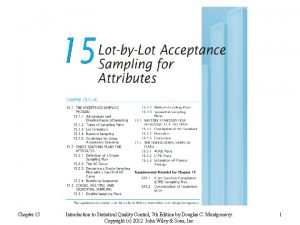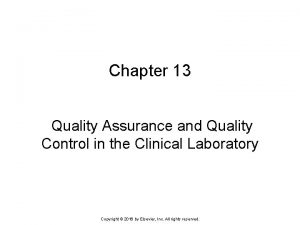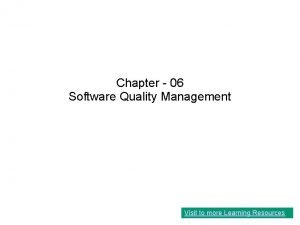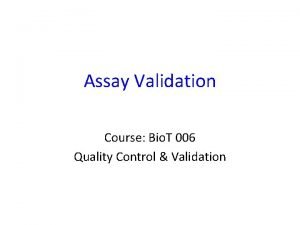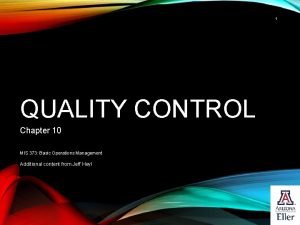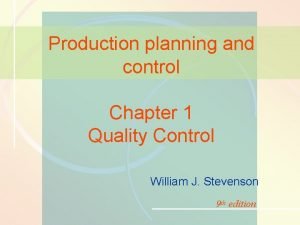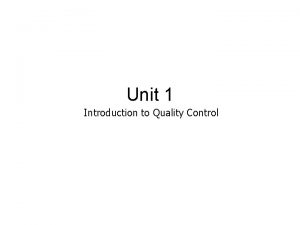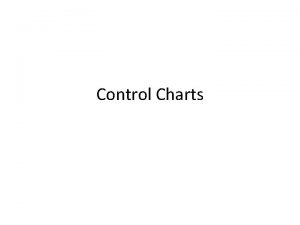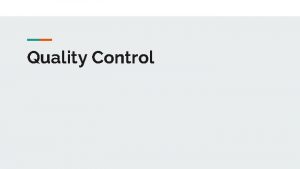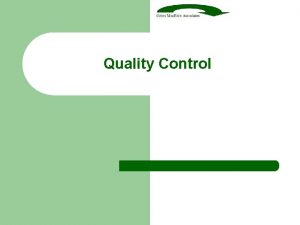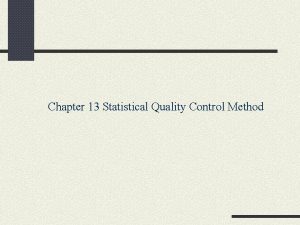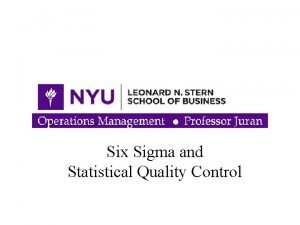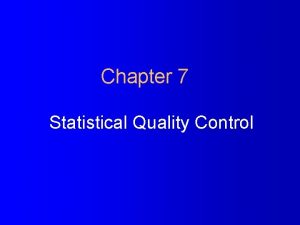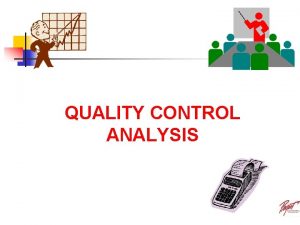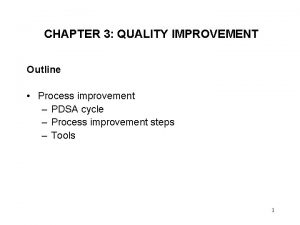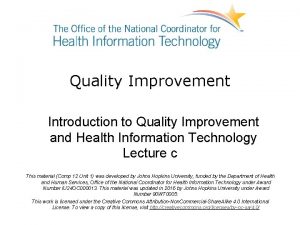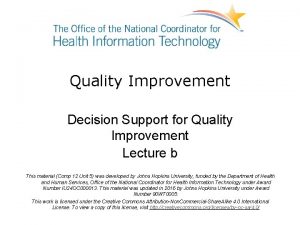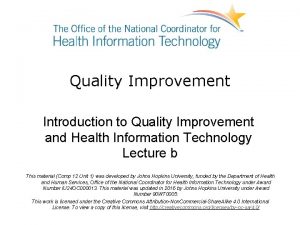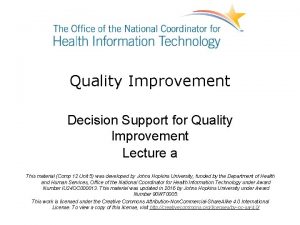Statistical Quality Control CHAPTERS OUTLINE 1 Quality Improvement

















































































- Slides: 81

Statistical Quality Control CHAPTERS OUTLINE 1. Quality Improvement & Statistics 1. 1 Statistical quality control 1. 2 Statistical process control 2. Introduction to Control Charts 2. 1 Basic principles 2. 2 Design of a control chart 2. 3 Rational subgroups 2. 4 Analysis of patterns on control 3. X-bar & R or S Control Charts 4. Control Chart for Individual Measurements 5. Process Capability 6. Attribute Control Charts 6. 1 P chart (Control chart for proportions) 6. 2 U chart ( control chart for defects per unit) 7. Control Chart Performance 8 Time-Weighted Charts 8. 1 Cumulative sum control chart 8. 2 Exponentially-weighted moving charts average control chart 9. Other SPC Problem-solving Tools 10. Implementing SPC 1

Learning Objectives for Chapters After careful study of this chapter, you should be able to do the following: 1. 2. 3. 4. 5. 6. 7. 8. 9. Understand the role of statistical tools in quality improvement. Understand the different types of variability, rational subgroups, and how a control chart is used to detect assignable causes. Understand the general form of a Shewhart control chart and how to apply zone rules (such as the Western Electric rules) and pattern analysis to detect assignable causes. Construct and interpret control charts for variables such as X-bar, R, S, and individuals charts. Construct and interpret control charts for attributes such as P and U charts. Calculate and interpret process capability ratios. Calculate the ARL performance for a Shewhart control chart. Construct and interpret a cumulative sum and exponentially-weighted moving average control chart. Use other statistical process control problem-solving tools. 2 © John Wiley & Sons, Inc. Applied Statistics and Probability for Engineers , by Montgomery and Runger.

Chapter 1: Quality Improvement and Statistics • Definitions of Quality means fitness for use - quality of design - quality of conformance Quality is inversely proportional to variability. 3 © John Wiley & Sons, Inc. Applied Statistics and Probability for Engineers , by Montgomery and Runger.

1. 1: Quality Improvement and Statistics • Quality Improvement Quality improvement is the reduction of variability in processes and products. Alternatively, quality improvement is also seen as “waste reduction”. 4 © John Wiley & Sons, Inc. Applied Statistics and Probability for Engineers , by Montgomery and Runger.

1. 2: Statistical Process Control • Statistical process control is a collection of tools that when used together can result in process stability and variance reduction 5 © John Wiley & Sons, Inc. Applied Statistics and Probability for Engineers , by Montgomery and Runger.

1. 2: Statistical Process Control The seven major tools are 1) Histogram 2) Pareto Chart 3) Cause and Effect Diagram 4) Defect Concentration Diagram 5) Control Chart 6) Scatter Diagram 7) Check Sheet 6 © John Wiley & Sons, Inc. Applied Statistics and Probability for Engineers , by Montgomery and Runger.

Chapter 2: Introduction to Control Charts 2. 1 Basic Principles • A process that is operating with only chance causes of variation present is said to be in statistical control. • A process that is operating in the presence of assignable causes is said to be out of control. • The eventual goal of SPC is the elimination of variability in the process. 7 © John Wiley & Sons, Inc. Applied Statistics and Probability for Engineers , by Montgomery and Runger.

Chapter 2: Introduction to Control Charts 2. 1 Basic Principles A typical control chart has control limits set at values such that if the process is in control, nearly all points will lie within the upper control limit (UCL) and the lower control limit (LCL). Figure 1: A typical control chart. 8 © John Wiley & Sons, Inc. Applied Statistics and Probability for Engineers , by Montgomery and Runger.

Chapter 2: Introduction to Control Charts 2. 1 Basic Principles Figure 2 Process improvement using the control chart. 9 © John Wiley & Sons, Inc. Applied Statistics and Probability for Engineers , by Montgomery and Runger.

Chapter 2: Introduction to Control Charts 2. 1 Basic Principles where k = distance of the control limit from the center line w = mean of some sample statistic, W. w = standard deviation of some statistic, W. 10 © John Wiley & Sons, Inc. Applied Statistics and Probability for Engineers , by Montgomery and Runger.

Chapter 2: Introduction to Control Charts 2. 1 Basic Principles Types of control charts • Variables Control Charts – These charts are applied to data that follow a continuous distribution. • Attributes Control Charts – These charts are applied to data that follow a discrete distribution. 11 © John Wiley & Sons, Inc. Applied Statistics and Probability for Engineers , by Montgomery and Runger.

Chapter 2: Introduction to Control Charts 2. 1 Basic Principles Popularity of control charts 1) Control charts are a proven technique for improving productivity. 2) Control charts are effective in defect prevention. 3) Control charts prevent unnecessary process adjustment. 4) Control charts provide diagnostic information. 5) Control charts provide information about process capability. 12 © John Wiley & Sons, Inc. Applied Statistics and Probability for Engineers , by Montgomery and Runger.

Chapter 2: Introduction to Control Charts 2. 2 Design of a Control Chart Suppose we have a process that we assume the true process mean is = 74 and the process standard deviation is = 0. 01. Samples of size 5 are taken giving a standard deviation of the sample average, is 13 © John Wiley & Sons, Inc. Applied Statistics and Probability for Engineers , by Montgomery and Runger.

2. 2 Design of a Control Chart • Control limits can be set at 3 standard deviations from the mean in both directions. • “ 3 -Sigma Control Limits” UCL = 74 + 3(0. 0045) = 74. 0135 CL= 74 LCL = 74 - 3(0. 0045) = 73. 9865 14 © John Wiley & Sons, Inc. Applied Statistics and Probability for Engineers , by Montgomery and Runger.

Chapter 2: Introduction to Control Charts 2. 2 Design of a Control Chart Figure 3 X-bar control chart for piston ring diameter. 15 © John Wiley & Sons, Inc. Applied Statistics and Probability for Engineers , by Montgomery and Runger.

Chapter 2: Introduction to Control Charts 2. 2 Design of a Control Chart • Choosing the control limits is equivalent to setting up the critical region for hypothesis testing H 0: = 74 H 1: 74 16 © John Wiley & Sons, Inc. Applied Statistics and Probability for Engineers , by Montgomery and Runger.

Chapter 2: Introduction to Control Charts 2. 3 Rational Subgrouping • Subgroups or samples should be selected so that if assignable causes are present, the chance for differences between subgroups will be maximized, while the chance for differences due to these assignable causes within a subgroup will be minimized. 17 © John Wiley & Sons, Inc. Applied Statistics and Probability for Engineers , by Montgomery and Runger.

Chapter 2: Introduction to Control Charts 2. 3 Rational Subgrouping Constructing Rational Subgroups • Select consecutive units of production. – Provides a “snapshot” of the process. – Good at detecting process shifts. • Select a random sample over the entire sampling interval. – Good at detecting if a mean has shifted – out-of-control and then back in-control. 18 © John Wiley & Sons, Inc. Applied Statistics and Probability for Engineers , by Montgomery and Runger.

Chapter 2: Introduction to Control Charts 2. 4 Analysis of Patterns on Control Charts • • Look for “runs” - this is a sequence of observations of the same type (all above the center line, or all below the center line) Runs of say 8 observations or more could indicate an out-of-control situation. – – Run up: a series of observations are increasing Run down: a series of observations are decreasing 19 © John Wiley & Sons, Inc. Applied Statistics and Probability for Engineers , by Montgomery and Runger.

Chapter 2: Introduction to Control Charts 2. 4 Analysis of Patterns on Control Charts Figure 4 X-bar control chart. © John Wiley & Sons, Inc. Applied Statistics and Probability for Engineers , by Montgomery and Runger. 20

Chapter 2: Introduction to Control Charts 2. 4 Analysis of Patterns on Control Charts Figure 5 An X-bar chart with a cyclic pattern. © John Wiley & Sons, Inc. Applied Statistics and Probability for Engineers , by Montgomery and Runger. 21

Chapter 2: Introduction to Control Charts 2. 4 Analysis of Patterns on Control Charts Figure 6 (a) Variability with the cyclic pattern. (b) Variability with the cyclic pattern eliminated. © John Wiley & Sons, Inc. Applied Statistics and Probability for Engineers , by Montgomery and Runger. 22

Chapter 2: Introduction to Control Charts 2. 4 Analysis of Patterns on Control Charts Western Electric Handbook Rules A process is considered out of control if any of the following occur: 1) One point plots outside the 3 -sigma control limits. 2) Two out of three consecutive points plot beyond the 2 sigma warning limits. 3) Four out of five consecutive points plot at a distance of 1 -sigma or beyond from the center line. 4) Eight consecutive points plot on one side of the center line. 23 © John Wiley & Sons, Inc. Applied Statistics and Probability for Engineers , by Montgomery and Runger.

Chapter 2: Introduction to Control Charts 2. 4 Analysis of Patterns on Control Charts Figure 7 The Western Electric zone rules. © John Wiley & Sons, Inc. Applied Statistics and Probability for Engineers , by Montgomery and Runger. 24

Chapter 3: X-bar and R or S Control Charts 3 -sigma control limits: The grand mean: 25 © John Wiley & Sons, Inc. Applied Statistics and Probability for Engineers , by Montgomery and Runger.

Chapter 3: X-bar and R or S Control Charts The average range: An unbiased estimator of : 26 © John Wiley & Sons, Inc. Applied Statistics and Probability for Engineers , by Montgomery and Runger.

Chapter 3: X-bar and R or S Control Charts Control Chart (from ): R Chart: 27 © John Wiley & Sons, Inc. Applied Statistics and Probability for Engineers , by Montgomery and Runger.

Chapter 3: X-bar and R or S Control Charts 3 -sigma control limits for S: An unbiased estimator of : 28 © John Wiley & Sons, Inc. Applied Statistics and Probability for Engineers , by Montgomery and Runger.

Chapter 3: X-bar and R or S Control Charts S Chart: Control Chart (from ): 29 © John Wiley & Sons, Inc. Applied Statistics and Probability for Engineers , by Montgomery and Runger.

Chapter 3: X-bar and R or S Control Charts Example 1 30 © John Wiley & Sons, Inc. Applied Statistics and Probability for Engineers , by Montgomery and Runger.

31 © John Wiley & Sons, Inc. Applied Statistics and Probability for Engineers , by Montgomery and Runger.

Chapter 3: X-bar and R or S Control Charts Example 1 32 © John Wiley & Sons, Inc. Applied Statistics and Probability for Engineers , by Montgomery and Runger.

Chapter 3: X-bar and R or S Control Charts Example 1 Figure 8: and R control charts for vane opening. 33 © John Wiley & Sons, Inc. Applied Statistics and Probability for Engineers , by Montgomery and Runger.

Chapter 3: X-bar and R or S Control Charts Example 1 34 © John Wiley & Sons, Inc. Applied Statistics and Probability for Engineers , by Montgomery and Runger.

Chapter 3: X-bar and R or S Control Charts Example 1 35 © John Wiley & Sons, Inc. Applied Statistics and Probability for Engineers , by Montgomery and Runger.

Chapter 3: X-bar and R or S Control Charts Example 1 Figure 9 The S control chart for vane opening. 36 © John Wiley & Sons, Inc. Applied Statistics and Probability for Engineers , by Montgomery and Runger.

Chapter 3: X-bar and R or S Control Charts Example 1 37 © John Wiley & Sons, Inc. Applied Statistics and Probability for Engineers , by Montgomery and Runger.

Chapter 3: X-bar and R or S Control Charts Example 1 Figure 10 The X-bar and R control charts for vane opening. 38 © John Wiley & Sons, Inc. Applied Statistics and Probability for Engineers , by Montgomery and Runger.

Chapter 4: Control Charts for Individual Measurements • What if you could not get a sample size n > 1 ? • Examples include – Automated inspection and measurement technology is used, and every unit manufactured is analyzed. – The production rate is very slow, and it is inconvenient to allow samples sizes of n > 1 to accumulate before analysis – Repeat measurements on the process differ only because of laboratory or analysis error, as in many chemical processes. • The individual control charts are useful for samples of sizes n = 1. 39 © John Wiley & Sons, Inc. Applied Statistics and Probability for Engineers , by Montgomery and Runger.

Chapter 4: Control Charts for Individual measurements • The Moving Range (MR) is defined as the absolute difference between two successive observations: MRi = |xi - xi-1| which will indicate possible shifts or changes in the process from one observation to the next. 40 © John Wiley & Sons, Inc. Applied Statistics and Probability for Engineers , by Montgomery and Runger.

Chapter 4: Control Charts for Individual Measurements Individuals Control Chart 41 © John Wiley & Sons, Inc. Applied Statistics and Probability for Engineers , by Montgomery and Runger.

Chapter 4: Control Charts for Individual Measurements Interpretation of the Charts • • X Charts can be interpreted similar to X-bar charts. MR charts cannot be interpreted the same as X-bar or R charts. Since the MR chart plots data that are “correlated” with one another, then looking for patterns on the chart does not make sense. MR chart cannot really supply useful information about process variability. More emphasis should be placed on interpretation of the X chart. 42 © John Wiley & Sons, Inc. Applied Statistics and Probability for Engineers , by Montgomery and Runger.

Chapter 5: Process Capability • Process capability refers to the performance of the process when it is operating in control. • Two graphical tools are helpful in assessing process capability: • Tolerance chart (or tier chart) • Histogram 43 © John Wiley & Sons, Inc. Applied Statistics and Probability for Engineers , by Montgomery and Runger.

Chapter 5: Process Capability Tolerance Chart Figure 12 Tolerance diagram of vane openings. 44 © John Wiley & Sons, Inc. Applied Statistics and Probability for Engineers , by Montgomery and Runger.

Chapter 5: Process Capability Histogram Figure 13 Histogram for vane openings. © John Wiley & Sons, Inc. Applied Statistics and Probability for Engineers , by Montgomery and Runger. 45

Chapter 5: Process Capability Ratio PCRk 46 © John Wiley & Sons, Inc. Applied Statistics and Probability for Engineers , by Montgomery and Runger.

Chapter 5: Process Capability Figure 14 Process Fallout and the process capability ratio (PCR). 47 © John Wiley & Sons, Inc. Applied Statistics and Probability for Engineers , by Montgomery and Runger.

Chapter 5: Process Capability Example 3 48 © John Wiley & Sons, Inc. Applied Statistics and Probability for Engineers , by Montgomery and Runger.

Chapter 5: Process Capability Figure 15 Mean of a six-sigma process shifts by 1. 5 standard deviations. 49 © John Wiley & Sons, Inc. Applied Statistics and Probability for Engineers , by Montgomery and Runger.

Chapter 6: Attribute Control Charts 6. 1 P-Chart (Control Chart for Proportions) 50 © John Wiley & Sons, Inc. Applied Statistics and Probability for Engineers , by Montgomery and Runger.

Chapter 6: Attribute Control Charts Example 4 51 © John Wiley & Sons, Inc. Applied Statistics and Probability for Engineers , by Montgomery and Runger.

Chapter 6: Attribute Control Charts Example 4 Figure 16 P chart for a ceramic substrate. © John Wiley & Sons, Inc. Applied Statistics and Probability for Engineers , by Montgomery and Runger. 52

Chapter 6: Attribute Control Charts Example 4 53 © John Wiley & Sons, Inc. Applied Statistics and Probability for Engineers , by Montgomery and Runger.

Chapter 6: Attribute Control Charts 6. 2 U-Chart (Control Chart for Defects per Unit) 54 © John Wiley & Sons, Inc. Applied Statistics and Probability for Engineers , by Montgomery and Runger.

Chapter 6: Attribute Control Charts Example 5 55 © John Wiley & Sons, Inc. Applied Statistics and Probability for Engineers , by Montgomery and Runger.

Chapter 6: Attribute Control Charts Example 5 56 © John Wiley & Sons, Inc. Applied Statistics and Probability for Engineers , by Montgomery and Runger.

Chapter 6: Attribute Control Charts Example 5 Figure 17 U chart of defects per unit on printed circuit boards. © John Wiley & Sons, Inc. Applied Statistics and Probability for Engineers , by Montgomery and Runger. 57

Chapter 7: Control Chart Performance Average Run Length • The average run length (ARL) is a very important way of determining the appropriate sample size and sampling frequency. • Let p = probability that any point exceeds the control limits. Then, 58 © John Wiley & Sons, Inc. Applied Statistics and Probability for Engineers , by Montgomery and Runger.

Chapter 7: Control Chart Performance 59 © John Wiley & Sons, Inc. Applied Statistics and Probability for Engineers , by Montgomery and Runger.

Chapter 7: Control Chart Performance Figure 18 Process mean shift of 2. 60 © John Wiley & Sons, Inc. Applied Statistics and Probability for Engineers , by Montgomery and Runger.

Chapter 8: Time-Weighted Charts 8. 1 Cumulative Sum Control Chart • The cusum chart incorporates all information in the sequence of sample values by plotting the cumulative sums of the deviations of the sample values from a target value. • If 0 is the target for the process mean, is the average of the jth sample, then the cumulative sum control chart is formed by plotting the quantity 61 © John Wiley & Sons, Inc. Applied Statistics and Probability for Engineers , by Montgomery and Runger.

62 © John Wiley & Sons, Inc. Applied Statistics and Probability for Engineers , by Montgomery and Runger.

Chapter 8: Time-Weighted Charts Figure 19 Plot of the cumulative sum for the concentration data, Table 7. 63 © John Wiley & Sons, Inc. Applied Statistics and Probability for Engineers , by Montgomery and Runger.

Chapter 8: Time-Weighted Charts Figure 20 The cumulative sum control chart. (a) The V-mask and scaling. (b) The cumulative sum control chart in operation. 64 © John Wiley & Sons, Inc. Applied Statistics and Probability for Engineers , by Montgomery and Runger.

Chapter 8: Time-Weighted Charts 8. 1 Cumulative Sum Control Chart CUSUM Control Chart 65 © John Wiley & Sons, Inc. Applied Statistics and Probability for Engineers , by Montgomery and Runger.

Chapter 8: Time-Weighted Charts Example 6 66 © John Wiley & Sons, Inc. Applied Statistics and Probability for Engineers , by Montgomery and Runger.

67 © John Wiley & Sons, Inc. Applied Statistics and Probability for Engineers , by Montgomery and Runger.

Chapter 8: Time-Weighted Charts Example 6 68 © John Wiley & Sons, Inc. Applied Statistics and Probability for Engineers , by Montgomery and Runger.

Chapter 8: Time-Weighted Charts Example 6 Figure 21: The CUSUM status chart for Example 6. 69 © John Wiley & Sons, Inc. Applied Statistics and Probability for Engineers , by Montgomery and Runger.

Chapter 8: Time-Weighted Charts 70 © John Wiley & Sons, Inc. Applied Statistics and Probability for Engineers , by Montgomery and Runger.

Chapter 8: Time-Weighted Charts 8. 2 Exponential Weighted Moving Average Control Chart 71 © John Wiley & Sons, Inc. Applied Statistics and Probability for Engineers , by Montgomery and Runger.

Chapter 8: Time-Weighted Charts 8. 2 Exponential Weighted Moving Average Control Chart 72 © John Wiley & Sons, Inc. Applied Statistics and Probability for Engineers , by Montgomery and Runger.

Chapter 8: Time-Weighted Charts 8. 2 Exponential Weighted Moving Average Control Chart Figure 22: EWMAs with λ=0. 8 and λ=0. 2 show a compromise between a smooth curve and a response to a shift 73 © John Wiley & Sons, Inc. Applied Statistics and Probability for Engineers , by Montgomery and Runger.

Chapter 8: Time-Weighted Charts 8. 2 Exponential Weighted Moving Average Control Chart EWMA Control Chart 74 © John Wiley & Sons, Inc. Applied Statistics and Probability for Engineers , by Montgomery and Runger.

Chapter 8: Time-Weighted Charts Example 7 75 © John Wiley & Sons, Inc. Applied Statistics and Probability for Engineers , by Montgomery and Runger.

Chapter 8: Time-Weighted Charts 8. 2 Exponential Weighted Moving Average Control Chart Figure 23 EWMA control chart for the Chemical Process Concentration Data from Minitab. 76 © John Wiley & Sons, Inc. Applied Statistics and Probability for Engineers , by Montgomery and Runger.

Chapter 9: Other SPC Problem-Solving Tools Pareto Diagram Figure 24: Pareto diagram for printed circuit board defects. 77 © John Wiley & Sons, Inc. Applied Statistics and Probability for Engineers , by Montgomery and Runger.

Chapter 9: Other SPC Problem-Solving Tools Cause-and-effect Diagram Figure 25: Cause-and-effect diagram for the printed circuit board flow solder process. © John Wiley & Sons, Inc. Applied Statistics and Probability for Engineers , by Montgomery and Runger. 78

Chapter 9: Other SPC Problem-Solving Tools Defect Concentration Diagram Figure 26 Defect concentration diagram for a printed circuit board. 79 © John Wiley & Sons, Inc. Applied Statistics and Probability for Engineers , by Montgomery and Runger.

Chapter 10: Implementing SPC • Strategic Management of Quality • Deming’s 14 points 80 © John Wiley & Sons, Inc. Applied Statistics and Probability for Engineers , by Montgomery and Runger.

Important Terms & Concepts of Chapters ARL Assignable causes Attributes control charts Average run length C chart Cause-and-effect diagram Center line Chance causes Control chart Control limits Cumulative sum control chart Defect concentration diagram Defects-per-unit chart PCR Deming’s 14 points PCRk Exponentially-weighted Problem-solving tools moving average Process capability control chart (EWMA) Process capability ratio False alarm Quality control Fraction-defective control R chart Rational subgroup Implementing SPC Run rule Individuals control chart S chart (X chart) Shewhart control chart Moving range Six-sigma process NP chart Specification limits P chart Pareto diagram 81 © John Wiley & Sons, Inc. Applied Statistics and Probability for Engineers , by Montgomery and Runger.
 Quality assurance cycle in nursing
Quality assurance cycle in nursing Compliance vs quality
Compliance vs quality Quality control operations management
Quality control operations management Montgomery quality control
Montgomery quality control Statistical quality control in operations management
Statistical quality control in operations management Introduction to statistical quality control
Introduction to statistical quality control Pengertian total quality management
Pengertian total quality management Gauginf
Gauginf Perform quality assurance
Perform quality assurance Quality control vs quality assurance pmp
Quality control vs quality assurance pmp Quality metrics pmp
Quality metrics pmp Concepts of quality control
Concepts of quality control Quality improvement vs research
Quality improvement vs research Qsen patient-centered care examples
Qsen patient-centered care examples Quality improvement paradigm
Quality improvement paradigm Continuous quality improvement plan example
Continuous quality improvement plan example Pocqi
Pocqi Define continuous quality improvement
Define continuous quality improvement Efmd quality improvement system
Efmd quality improvement system Indiana perinatal quality improvement collaborative
Indiana perinatal quality improvement collaborative Continuous quality improvement program planning worksheet
Continuous quality improvement program planning worksheet Tea quality improvement
Tea quality improvement Xerox problem solving process
Xerox problem solving process Sustainability in quality improvement
Sustainability in quality improvement Cotinuous
Cotinuous Quality improvement
Quality improvement Juran 10 steps to quality improvement
Juran 10 steps to quality improvement Swot analysis for quality
Swot analysis for quality Mqii
Mqii Quality improvement
Quality improvement Data driven quality
Data driven quality Rapid cycle quality improvement
Rapid cycle quality improvement Crosby quality is free
Crosby quality is free Statistical quality assurance in software engineering
Statistical quality assurance in software engineering Statistical software quality assurance
Statistical software quality assurance Upper brushy creek water control and improvement district
Upper brushy creek water control and improvement district Statistical process control ppt
Statistical process control ppt Statistical control in research
Statistical control in research Statistical inventory control
Statistical inventory control Statistical process control tutorial
Statistical process control tutorial Sandia
Sandia Statistical process control
Statistical process control 20%ของ300
20%ของ300 Statistical process control definition
Statistical process control definition Statistical process control
Statistical process control What is a quote sandwich
What is a quote sandwich Support control and movement lesson outline
Support control and movement lesson outline Lesson outline structure movement and control
Lesson outline structure movement and control David a garvin 8 dimensions of quality
David a garvin 8 dimensions of quality What is tqm
What is tqm Qa ipc
Qa ipc Contoh tqc
Contoh tqc What is sampling plan in quality control
What is sampling plan in quality control Average run length in quality control
Average run length in quality control Software quality assurance plan
Software quality assurance plan Quality control log examples
Quality control log examples Quality control shanghai
Quality control shanghai Seismic quality control
Seismic quality control Quality control system in business plan
Quality control system in business plan Quality determination
Quality determination Material control procedure
Material control procedure External quality control in blood bank
External quality control in blood bank Quality control of fresh fruits and vegetables
Quality control of fresh fruits and vegetables Brewery quality control
Brewery quality control Quality control in hematology
Quality control in hematology Quick response quality control (qrqc)
Quick response quality control (qrqc) Quality test for parenterals
Quality test for parenterals What is a quality control
What is a quality control Tqm circle
Tqm circle Quality control documentation
Quality control documentation Chemical indicator for system 1e
Chemical indicator for system 1e Dqc data quality control
Dqc data quality control Average run length in quality control
Average run length in quality control Average run length in quality control
Average run length in quality control What is sampling plan in quality control
What is sampling plan in quality control What is sampling plan in quality control
What is sampling plan in quality control Levey-jennings chart shift and trend
Levey-jennings chart shift and trend Six sigma methodology defines three core steps
Six sigma methodology defines three core steps Quality control assay
Quality control assay Asq control chart
Asq control chart Production planning and quality control
Production planning and quality control Introduction to quality control
Introduction to quality control


